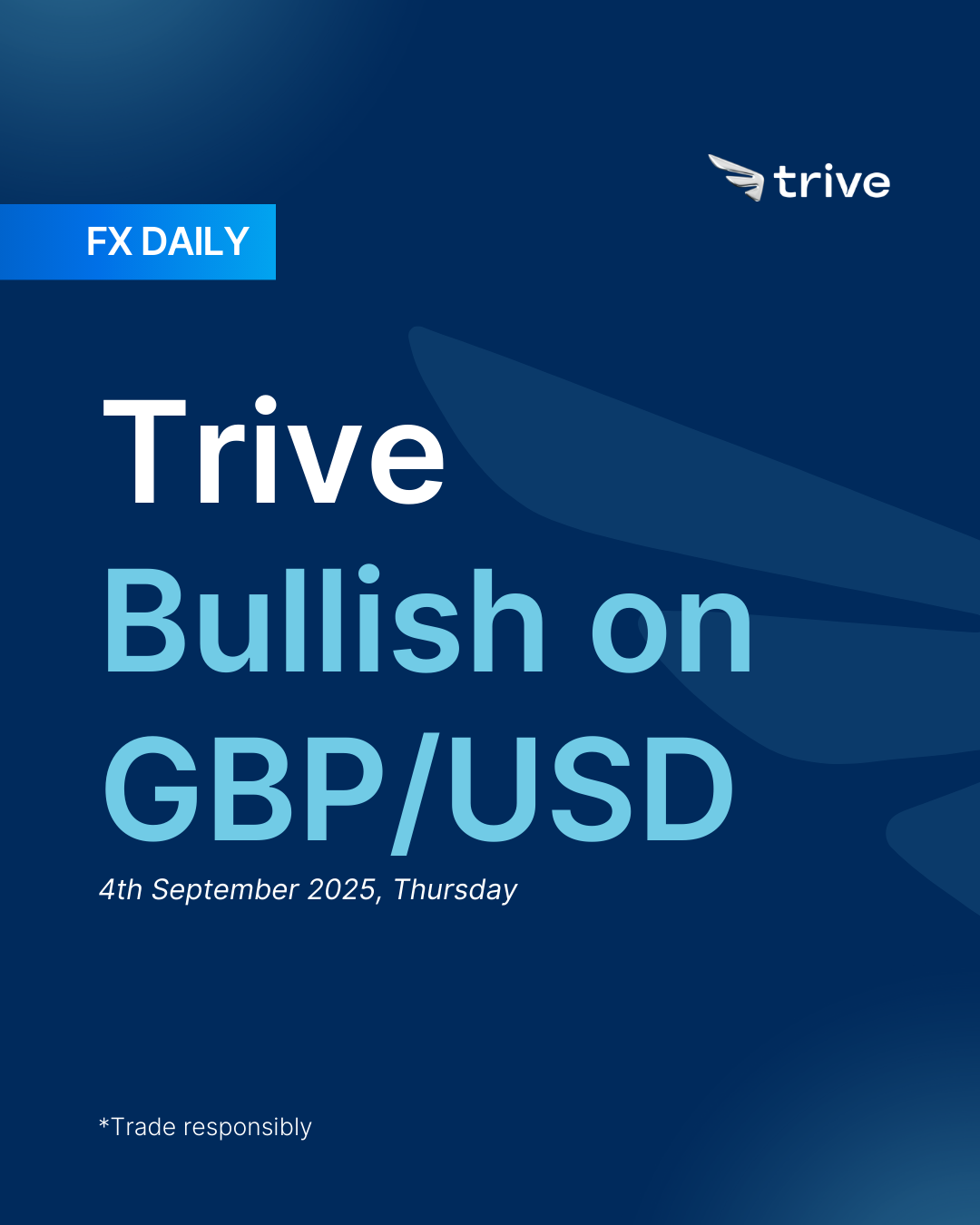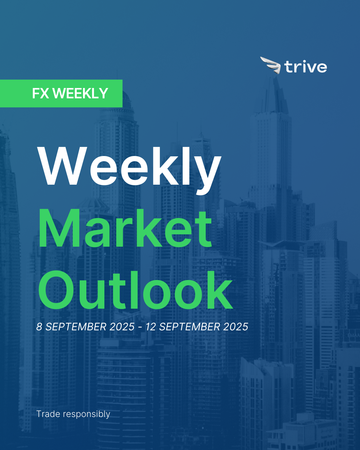FX Daily: Trive Bullish on GBP/USD

Sterling struggled last week as tax headlines and cautious BoE rhetoric weighed, keeping GBP/USD capped below 1.3500. But we see these risks as fading — UK services remain resilient, real incomes are improving, and the BoE is likely to ease slower than peers. With US Fed credibility under fire and policy divergence narrowing, we prefer buying dips, looking for GBP/USD to grind higher once fiscal nerves ease.
GBP: Short term bullish
The British Pound underperformed its G10 peers, grinding lower through the week as a quiet economic calendar left it exposed to US Dollar volatility and a growing wave of negative domestic fiscal headlines. After a muted start due to the UK bank holiday, Cable was pulled around by the swings in the DXY, but as the week progressed, a distinctly bearish UK story began to dominate. A steady stream of reports suggesting that the government may raise taxes on landlords and introduce a potential windfall tax on banks weighed heavily on sentiment, fueling concerns about the country’s fiscal outlook ahead of the Autumn Budget. Comments from BoE hawk Catherine Mann, who argued for holding rather than raising rates, provided no support for the currency. Sterling repeatedly failed to hold the 1.3500 level even during moments of dollar weakness and ultimately ended the week with a clear downward bias, testing important technical support.
Sterling was hit hardest by mounting tax concerns. On Thursday, The Times reported that the Treasury is considering taxing landlords further by imposing national insurance on rental income. The following day, the IPPR think tank recommended a windfall tax on commercial banks, a proposal senior bankers warned would be politically attractive but damaging in practice. These developments fueled uncertainty around Chancellor Reeves’ upcoming Autumn Budget. At the same time, reports suggested that Prime Minister Starmer is preparing a cabinet reshuffle, including the appointment of former BoE Deputy Governor Minouche Shafik as the new chief economic adviser. While intended to strengthen economic expertise, the timing reinforced the impression of a government in flux before a key fiscal event.
The Bank of England also added to the cautious tone. Governor Andrew Bailey opened the week with a warning about the “acute challenge” posed by weak underlying growth and lower labor force participation, painting a downbeat picture of the economy’s long-term prospects. On Tuesday, Catherine Mann, a known hawk, said that a more persistent hold on Bank Rate was appropriate for now. Coming from one of the strongest advocates for higher rates, this signal for a pause carried weight and did nothing to lift the Pound.
The economic calendar offered little support. With no major data releases, the currency was left at the mercy of political headlines and external drivers. The only notable release, the BRC Shop Price Index for August, showed food inflation rising to its highest level since February 2024, underscoring the ongoing strain on consumers.
In terms of market dynamics, GBP/USD moved largely in response to the US Dollar, particularly at the start of the week. The pair struggled to sustain levels above 1.3500, finding consistent resistance from the negative fiscal narrative. The failure to hold above its 50-day moving average near 1.3493 signaled technical weakness, with the currency ending the week under pressure and probing support around the 21-day and 100-day moving averages at 1.3445–1.3450.
Sterling slipped this week. With little fresh UK data, GBP mostly followed the Dollar early on, then the domestic story turned heavier as tax talk on landlords and a possible bank windfall levy dominated the headlines ahead of the Autumn Budget. BoE messaging leaned cautious, and every push toward 1.3500 faded, leaving Cable on the back foot and testing support by week’s end. In short, the market is balancing a still supportive rates backdrop against growing fiscal uncertainty and for now the latter is doing more of the talking.
Near term, our bias is Neutral. We expect two way, range trade rather than a clean trend. Earlier BoE hawkishness still helps on dips, but the fiscal tape caps rallies. The next UK CPI is the swing risk, another firm print would back the BoE’s caution and keep dips supported, a cooler reading would revive cut bets and likely limit bounces. Also watch for signs the market is starting to look through the fiscal scare: officials pushing back on tax proposals, bank equities stabilizing, and less FX impact from UK-specific headlines would all be tells that the risk premium is fading.
Further out, our bias is Weak Bullish. We think UK resilience, steady services activity, and a slower BoE easing path versus peers can support GBP on dips as long as fiscal policy lands credibly. Real incomes are improving at the margin and energy dynamics are far calmer than in prior years, which should help growth stabilize. If the Autumn Budget signals stability rather than surprise, and if US growth cools just enough to keep the Dollar from reasserting, we see room for a grind higher rather than a fade. We’d lean into that view by buying setbacks into support and adding on a clean reclaim and hold above recent highs. Risks to this view include a messy Budget that dents confidence, a sharp global risk-off, or a renewed inflation scare that forces policy in an unfriendly way for growth; absent those, we favor modest GBP appreciation over the medium run.
USD: Focus on NFP this week
The US Dollar was volatile in a week dominated by an unprecedented clash between the White House and the Federal Reserve, which overshadowed economic data and strengthened expectations for a September rate cut. The DXY began the week on firm ground, recovering from post-Jackson Hole lows, but the tone shifted on Tuesday when President Trump announced the firing of Fed Governor Lisa Cook. Cook’s refusal to resign and her subsequent lawsuit against the President created significant uncertainty around the Fed’s independence. The dollar sold off sharply as the market priced in a more politically influenced and therefore more dovish central bank. While some data, such as an upward revision to Q2 GDP growth, offered temporary support, the dominant theme was the erosion of the Fed’s credibility. This was reinforced by highly dovish comments from Fed Governor Waller, a leading candidate to become the next Fed Chair, who explicitly backed a September cut. The DXY ended the week near its lows around 97.70, with traders largely ignoring in-line inflation data and focusing instead on a Fed seemingly compelled to ease policy.
The week’s central story was President Trump’s attempt to remove Fed Governor Lisa Cook from the board, citing alleged false mortgage statements. Cook immediately challenged the move as unlawful, refused to resign, and filed a lawsuit against the President. This legal battle has created uncertainty around her FOMC voting rights and is viewed by markets as a direct attack on central bank independence. Reports also emerged that the Trump administration is already considering replacements, including Stephen Miran and David Malpass, and is exploring ways to increase its influence over the Fed’s twelve regional banks.
Meanwhile, Fed Governor Waller gave remarks on Thursday night that added weight to the dovish case. He stated his support for a 25 basis point cut at the September meeting and said he expects additional cuts over the next three to six months, estimating that the current policy rate is 1.25 to 1.50 percent above neutral. As a result, Fed Funds futures pricing for a September rate cut solidified at around a 90 percent probability, with about 55 basis points of total easing expected by the end of the year.
On the economic front, the July PCE report, the Fed’s preferred inflation measure, came in as expected. Headline inflation held steady at 2.6 percent year over year, while core inflation ticked up to 2.9 percent from 2.8 percent. The “supercore” measure, which excludes housing from services, rose 0.4 percent month over month for the third consecutive month, pointing to persistent underlying price pressures. The second estimate of Q2 GDP was revised up to a strong 3.3 percent from 3.0 percent, with corporate profits also revised sharply higher. However, the dollar failed to gain momentum from the release. Activity data was weaker, as the August Chicago PMI dropped to 41.5, the lowest since the pandemic, signaling a sharp contraction in regional business activity. The July Advanced Goods Trade Balance widened significantly to -$103.6 billion as imports surged, creating downside risks for Q3 GDP. The labor market, however, remained resilient, with initial jobless claims holding steady at 229,000.
On the trade and geopolitical side, the administration doubled tariffs on most Indian imports to 50 percent, citing India’s continued purchases of Russian oil. President Trump also threatened substantial additional tariffs on countries imposing digital services taxes on US technology firms. The administration permanently eliminated the longstanding de minimis rule that allowed packages valued under $800 to enter the US duty-free, a move that tightens trade policy for small-parcel e-commerce imports from all countries. Meanwhile, China’s Ministry of Commerce confirmed that a trade negotiator would visit Washington, although these meetings are considered deputy-level and not part of formal negotiations.
Market sentiment was dominated by concerns about Fed independence, overshadowing the economic data. The dollar weakened while the Treasury yield curve steepened, with short-term yields falling on expectations of imminent rate cuts, while long-term yields remained firm on concerns that a politically compromised Fed would tolerate higher inflation. Toward the end of the week, some of the choppy price action was also attributed to month-end rebalancing flows, with models pointing to mild US dollar selling.
Near term, we stay weak bearish on the dollar. The attempted removal of Governor Lisa Cook and her lawsuit have raised the perceived risk to Fed independence, reinforcing expectations for policy easing and making haven pops feel shorter-lived. Governor Waller then openly backed a September cut and signaled more over the next 3–6 months, which keeps front-end yields heavy and rallies prone to fade. In data, July PCE was broadly in line while the Chicago PMI slumped, and the goods trade gap widened, none of which challenges the easing narrative. We’d sell strength unless incoming labor, inflation or PMI’s materially lower September cut odds.
Longer term, we still see a gradual USD softening as U.S. rate differentials compress and “U.S. exceptionalism” cools. Trade policy shifts add a wrinkle, ending the de minimis exemption and steep new tariffs on India are inflationary at the margin but growth-negative. Taken together, markets are reading them as front-end dovish and curve-steepening, which fits a “sell the rallies” USD regime unless inflation proves stickier than we expect. We’ll stay tactically flexible, but structurally biased to a weaker dollar while headline risk around Fed governance and trade keeps volatility high.
 GBP/USD 4H
GBP/USD 4H
Disclaimer
This material is provided for informational purposes only and does not constitute financial, investment, or other advice. The opinions expressed in this material are those of the author and do not necessarily reflect the views of Trive International. No opinion contained in this material constitutes a recommendation by Trive International or its author regarding any particular investment, transaction, or investment strategy. This material should not be relied upon in making any investment decision.
The information provided does not consider the individual investment objectives, financial situation, or needs of any specific investor. Investors should seek independent financial advice tailored to their individual circumstances before making any investment decisions. Trive International shall not be liable for any loss, damage, or injury arising directly or indirectly from the use of this information or from any action or decision taken as a result of using this material.
Trive International may or may not have a financial interest in the companies or securities mentioned. The value of investments may fluctuate, and investors may not get back the amount they originally invested. Past performance is not indicative of future results.
For more information about Trive International, please visit http://trive.com/int
Additional Information
Investing involves risk, including the potential loss of principal. Diversification and asset allocation strategies do not ensure a profit or guarantee against loss. The content in this material is subject to change without notice and may become outdated or inaccurate over time. Trive International does not undertake any obligation to update the information in this material.
By accessing this material, you acknowledge and agree to the terms of this disclaimer. If you do not agree with these terms, please refrain from using this information.
No comments
Home
Trive
TriveHub





0 comments